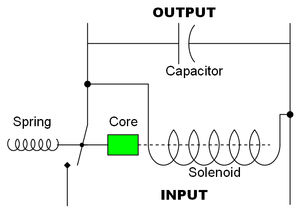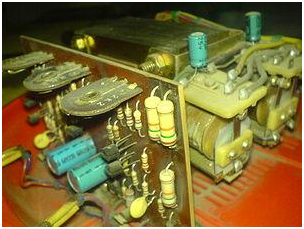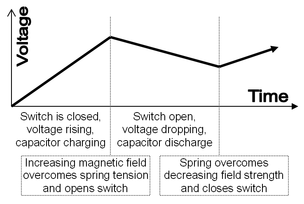Electromechanical regulators

Circuit design for a simple electromechanical voltage regulator

Interior of an old electromechanical voltage regulator

Graph of the voltage output on the time scale.
In older electromechanical regulators, voltage regulation can be easily accomplished by coiling the sensing wire to make the electromagnet. The magnetic field produced by current attracts a moving ferrous core held back under the spring tension or the gravitational pull. As voltage increases, so does the current, strengthening magnetic field produced by the coil and pulling back core towards the field. Magnet is physically connected to the mechanical power switch, which opens as magnet moves into field. As voltage decreases, so does the current, releasing spring tension or weight of the core and making it to retract. This closes the switch and lets the power to flow once more.
If the mechanical regulator design is sensitive to the small voltage fluctuations, motion of the solenoid core can be used to move a selector switch across the range of resistances or transformer windings to gradually step output voltage up or down, or to rotate the position of the moving- coil AC regulator.
Early automobile generators and alternators had the mechanical voltage regulator using one, two, or three relays and a number of resistors to stabilize the generator's output at slightly more than 6 or 12 V, independent of engine's rpm or varying the load on the vehicle's electrical system.
Essentially, the employed pulse width modulation of the relay to regulate the output of generator, controlling the field current reaching the generator and in this way controlling output voltage produced.
The regulators used for the generators also disconnect the generator when it was not producing electricity, thus preventing battery from discharging back into generator and attempting to run it as a motor. The rectifier diodes in the alternator automatically perform this function so that the specific relay is not needed; this appreciably simplified regulator design.
Now more modern designs use solid state technology (transistors) to perform same function which the relays perform in the electromechanical regulators.
Email based Electronics Devices and circuits assignment help - homework help at Expertsmind
Are you searching Electronics Engineering assignment help expert for help with Electromechanical Regulators questions? Electromechanical Regulators topic is not easier to learn without any external help? We at www.expertsmind.com offers free lecture notes for Electronics Devices and circuits assignment help and Electronics Devices and circuits homework help. Live tutors are available 24x7 hours for helping students in their Electromechanical Regulators related problems. We provide step by step Electromechanical Regulators question's answers with 100% plagiarism free content. We prepare quality content and notes for Electromechanical Regulators topic under Electronics Devices and circuits theory and study material. These are avail for subscribed users and they can get advantages anytime.
Why Expertsmind for assignment help
- Higher degree holder and experienced experts network
- Punctuality and responsibility of work
- Quality solution with 100% plagiarism free answers
- Time on Delivery
- Privacy of information and details
- Excellence in solving electronics engineering questions in excels and word format.
- Best tutoring assistance 24x7 hours